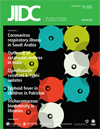Rethinking therapeutic decisions for hepatitis B infection in Syria: insights into molecular monitoring
DOI:
https://doi.org/10.3855/jidc.2596Keywords:
hepatitis B virus, Syria, therapeutic decisions, viral genotype, mutant variants, drug resistanceAbstract
Introduction: Hepatitis B virus patients are usually treated in Syria with alpha interferon and nucleos(t)ide analogues. Genotypic viral factors causing inadequate response or relapse following initial response are not routinely investigated. This study aimed to explore and discuss local therapeutic decisions from a molecular perspective.
Methodology: Fifty patients with hepatitis B from Syria were tested for HBV genotyping and drug-resistance mutations by DNA sequencing.
Results: All patients had genotype D, which is characterized by relatively low response to interferon-based therapy. Drug-resistant viral mutant variants were detected in one fifth of the enrolled patients, and distributed similarly in both nucleos(t)ide analogues-naïve and -treated patients. However, nucleos(t)ide analogues-based therapy was associated with the existence of more mutations and hence increased resistance.
Conclusions: Investigating HBV genotypes and drug-resistance mutations to support treatment decisions is critically needed for efficient therapy and patients’ survival.
Downloads
Published
How to Cite
Issue
Section
License
Authors who publish with this journal agree to the following terms:
- Authors retain copyright and grant the journal right of first publication with the work simultaneously licensed under a Creative Commons Attribution License that allows others to share the work with an acknowledgement of the work's authorship and initial publication in this journal.
- Authors are able to enter into separate, additional contractual arrangements for the non-exclusive distribution of the journal's published version of the work (e.g., post it to an institutional repository or publish it in a book), with an acknowledgement of its initial publication in this journal.
- Authors are permitted and encouraged to post their work online (e.g., in institutional repositories or on their website) prior to and during the submission process, as it can lead to productive exchanges, as well as earlier and greater citation of published work (See The Effect of Open Access).








